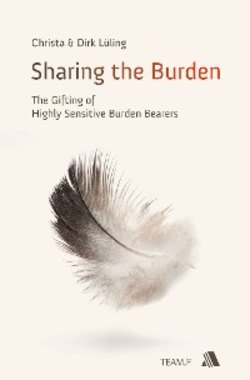Читать книгу Sharing the Burden - Christa Lüling - Страница 7
Introduction
ОглавлениеDuring a car trip several years ago, we decided to listen to a taped teaching by John Sandford, an influential Christian counselor, lecturer and author, entitled “Healing for the Wounded Burden Bearer.” At first, we hadn’t known what to expect from a lecture with that title, but the more we listened, the more fascinated we became. Suddenly, light was being shed on an important part of our lives that had often caused us problems. Christa felt that finally someone had found a way to understand her and describe her personality, and when she prayed along with the prayer at the end, she immediately felt relieved. Later, we were helped very much by personal conversations with John Sandford in which he explained in more detail the gift of burden bearing. Ever since, we have come back again and again to this topic, discovering new aspects of it every time. Whenever Christa teaches on it in our Team.F Counseling School, the response is overwhelming. More than 80% of the students fit into this personality description and feel like they are being understood and described. They are relieved to finally be able to understand what they sense and how they react, and see many past hurtful experiences in a new light.
John and Paula Sandford are considered pioneers in the area of inner healing. In the 90’s, they often spoke at our seminars. Their seminars, books and friendship provided invaluable input for not only our lives, but also the counseling aspect of the Christian family ministry group we founded called Team.F. This valuable beginning was expanded and complemented last year when we came across Elaine Aron’s book The Highly Sensitive Person and Georg Parlow’s German book Zart Besaitet [Highly Sensitive], both of which provide a detailed description of the highly sensitive personality. The abundance of information about highly sensitive people that we found in these books and on the Internet confirmed what we had experienced and observed.
Many highly sensitive people are emotional burden-bearers; of these, many have very wounded souls. It is primarily for these people that we have written this book. We have only described the characteristics of highly sensitive people in as much detail as is necessary to provide a basic understanding of the personality of a burden bearer. So it could happen that you don’t see yourself in the description of a highly sensitive person, but do see yourself reflected in our discussions of burden bearing or the healing of wounded souls.
There is a great need for information on this topic because, according to Elaine Aron, about one-fifth of all people are highly sensitive. They have very delicate sensibilities and a wonderful gift. Unfortunately, some of them never find their niche in our competitive society because they don’t function the way most people do. With their perceptions, reactions and values, they often feel misunderstood and “different.” Unfortunately, they are often confirmed in this by judgmental reactions from those around them. Because of things that have happened to them in the past, many are plagued by self-doubt and insecurity. More than a few have seemingly random emotional or even physical pain, and some are easily emotionally or intellectually confused due to perception overload. In order to enter into or reclaim a joyful life, they need to be freed from the yoke of their unconscious burdens and healed of the painful experiences in their past. If they can also learn to protect themselves from too many perceptions, they can handle their gift very constructively in everyday life. Our society needs highly sensitive people! They deserve to be seen and respected for what they are and given a place appropriate for them.
This book is based to a large extent on our own experiences and observations, coupled with friends’ stories. Our hearts’ desire is to open our readers’ eyes and hearts to understand not only this almost entirely unknown and neglected topic, but even more importantly, the highly sensitive people themselves. Please feel free to send us your feedback and/or tell us your story; we are convinced that there is so much more to this issue than we have yet discovered. We would like to take this opportunity to thank all of our friends who have shed light on this area and enriched this book by telling their stories. To protect them and their families, we have changed their names.
Much of this book is about Christa and her experiences, so when the first-person form is used without explanation, Christa is telling her personal story.
Christa and Dirk Lüling
